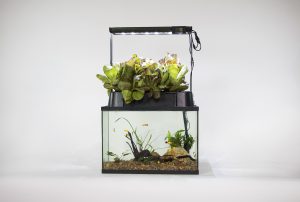By adding the water from the system to the fish in the bag the fish are able to acclimate to the ph of the system. this is as important as temperature acclimating. wait another 20 minutes and then gently pour the fish into the fish tank. once the fish are added, cycling of the system has begun.. This article will explore how raising fish and plants together (aquaponics) is one way to conserve, clean, and protect our freshwater sources. aquaponics uses a hydroponic-style system in which the plants are grown with minimal or no soil. however, aquaponics uses the waste from fish farming as the nutrient source in the system.. Aquaponics is a system of farming in which the hydroponic farming, which involves growing the plants without soil is mixed with the aqua farming which involves basic fish farming.this method is very much efficient in producing both fish and plants simultaneously. the waste generated by fish in the aquaculture portion will be separated into bacteria with dissolved nutrients like nitrogen.
Adding azolla to tilapia feed in aquaponics
Aquaponics blog - aquaponics system solutions
Eco-cycle aquaponics kit - ecolife conservation
Adding fish at system startup. we start all our systems with fish in them.there are “experts” who recommend “fishless cycling”. however, we have never bothered to, simply because starting up with fish works so well there are some pitfalls to avoid, and we discuss them in this section. we call this process “startup”, because you only have to do it once in the lifetime of your system. While not considered a fish per se, crustaceans offer aquaponics hobbyist another choice to add to their system. and it doesn’t have to be a matter of either/or. crustaceans – such as freshwater prawn, crayfish, mussels, oysters, and even lobsters – can either be added to aquaponics system alongside fish or within their own separate tank..



0 komentar:
Posting Komentar